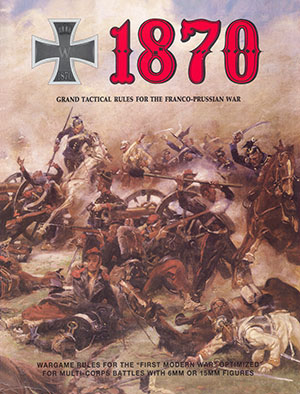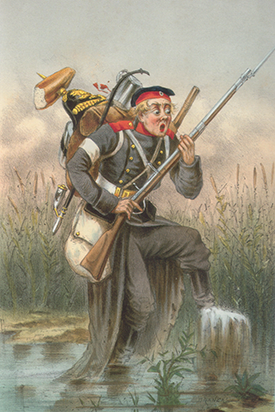
 No matter how well proofed, it seems, there’s always a few goofs, omissions, or clarifications that need to be addressed in any product as detailed as 1870. Here’s a few that have come up; I’ll try to address and post others that alert readers may bring to my attention on this site as they come up.
No matter how well proofed, it seems, there’s always a few goofs, omissions, or clarifications that need to be addressed in any product as detailed as 1870. Here’s a few that have come up; I’ll try to address and post others that alert readers may bring to my attention on this site as they come up.
- In the Visibility section (page 3), units in buildings are noted as being automatically spotted at 2 inches and below, implying that visibility in towns is 2 inches. This is incorrect. Visibility in towns (i.e., between opposing units in the same town) is just like in woods: 1 inch.
- In the Fighting Formation Guide (on page 5) and on the Cheat Sheet, in the paragraph Line of two battalions up, one back (which formation is more properly and succinctly known as a “supported line”), the sentence that reads “It also serves as a tactical reserve behind which the front stands may regroup if thrown back by enemy action” is rescinded. Since a morale result affects a whole regiment, the regiment’s reserve stand would retreat with the front stands, if they were thrown back by hostile action, not stay and give the front stands a refuge behind which they could regroup. The presence of the reserve stand does preclude the enemy’s “free shot” at the retreating regiment, however.
- On page 25, the manner in which charging cavalry and counter-charging cavalry are brought together by pro-rating their movement means that the charging cavalry – with their charge bonus – will always have more movement remaining after a collision than the defending cavalry. The appropriate sentence describing this is now corrected to read: “If there is a counter-charge, the defender also rolls for a charge bonus in the same manner, and attacker and defender are placed together at some likely spot long the route of charge at the defender’s discretion.”
- In the Orders of Battle (page 93), a couple of 6-pdr batteries were left out of the Saxon XII Corps artillery “regiment”. The correct listing should be: 4 x 6-pdr, 2 x 4 pdr, and 1 4-pdr HA batteries (the other HA battery is shown with the cavalry division, where it usually was assigned).
- Also in the OBs (page 94), Mulzer’s uhlan brigade in the II Bavarian Corps was inadvertently shown as a division.
- In the Gravelotte-St Privat scenario (page 64), one French Imperial Guard battalion too many of the 3rd Grenadier Regt is shown as present with the Army of the Rhine; in fact, it and a squadron of the Guides were detached on 16 August to escort Napoleon III to Chalons.
- In the Coulmiers scenario (page 74), the arrival times of Jaureguiberry’s two brigades in the OB should be omitted. Both are on board on turn one, as shown on the map. There’s a battalion missing on the map in Jaureguiberry’s division, too; there should be 13, as noted in the OB.
- On page 85, in Douay’s 2nd Division (MacMahon’s 1st Corps), substitute 78th Line for 76th Line. In Dumont’s 3rd Division (Douay’s 7th Corps), substitute 72nd Line for the 79th Line.
- On page 87, in Ducrot’s 1st Corps of the Army of Chalons, the following changes should be noted since 1 August:
- 1st Division: Wolff succeeded Ducrot
- 2nd Division: Pelle succeeded Douay
- 3rd Division: l’Heriller succeeded Raoult. In the 1st Brigade, lose 3rd Chasseurs, add the 8th Chasseurs. Lose 1 4-pdr battery
- 4th Division: Lose the 87th Line, add the 3rd Marche and 1 Guard Grenadier battalion
- Cavalry Division: Michel succeeded Duhesme on 25 August
- Corps Reserve Artillery: lose 1 4-pdr and 1 12-pdr battery
- The addition of the 1st Marche Regt in the 2nd Division (shown) occurred on 28 August
- Same page, Douay’s 7th Corps: lose the 6th Dragoons and 6th Hussars in the Cavalry Division
- Same page, Vinoy’s 13th Corps: Blanchard’s division is infantry, not cavalry
- Same page, Failly was succeeded as commander, 5th Corps, by Wimpffen on 31 August
- In that corps’ 2nd Division, lose the 84th and 97th Regiments
- Lose one 4-pdr battery from the corps’ reserve artillery
- Same page, Lebrun’s 12th Corps:
- Add ½ Chasseur battalion to Grandchamp’s and LaCretelle’s divisions
- In Vassoigne’s 3rd Division, lose the mitrailleuse battery, add a 4-pdr battery
- In the corps reserve artillery, there should be 8 4-pdr and 3 12-pdr batteries
- Same page, Napoleon’s escort should not include the Guard Grenadier battalion (see 1st Corps); Besides the Cent-Guard squadron and a few Gendarmes d’Elite, only the 5th squadron of the Guides escorted the Emperor after he joined the Army of Chalons.
- On page 93 of the Prussian OBs, Wrangel’s 18th Division in the IX Corps is shown as a cavalry unit. It was infantry.
- Just to be perfectly correct, it should be noted that Imperial French light cavalry regiments (Hussars, Chasseurs) and all the Imperial Guard cavalry regiments were five squadrons strong; this could translate, for those willing to overlook the regiments’ chronic under-manning, as one stand of 2 points, and one of 3 points.
- Concerning artillery usage. It was common practice during this era to group two, three, or four batteries on the battlefield whenever possible (without regard for unit affiliation) into ad hoc “battalions”. Each of these artillery groups/battalions would engage common targets under the direction of the senior artillerist present. The Artillery Tables in all the Grand Tactical Rules games were calibrated to give the most accurate results when two or three grouped batteries engage the same target simultaneously, i.e., with one die roll. This I tried to encourage in the rules by subjecting lone batteries to severe morale penalties. At the same time, the Artillery Table compensates individual batteries somewhat by inflating their chances of inflicting damage on a target for playability’s sake …but as “single stand units” there is a big penalty to pay for operating independently. The individual batteries lose Morale Points three times as fast as multiple-stand “battalions.”
 The rule should be, therefore, that if two or three batteries are grouped together to gain the “battalion” morale benefit, they must all engage the same target as well, massing their points and firing on it with a single die roll.
The rule should be, therefore, that if two or three batteries are grouped together to gain the “battalion” morale benefit, they must all engage the same target as well, massing their points and firing on it with a single die roll.

